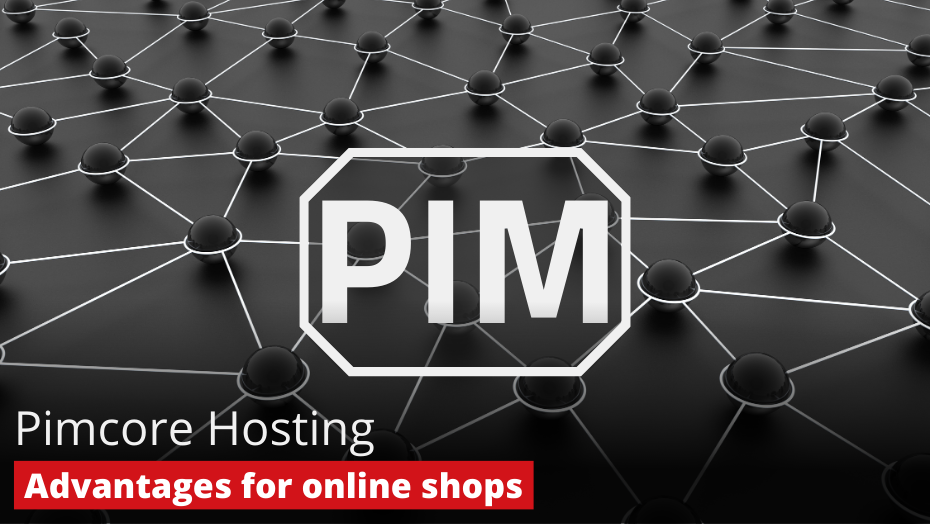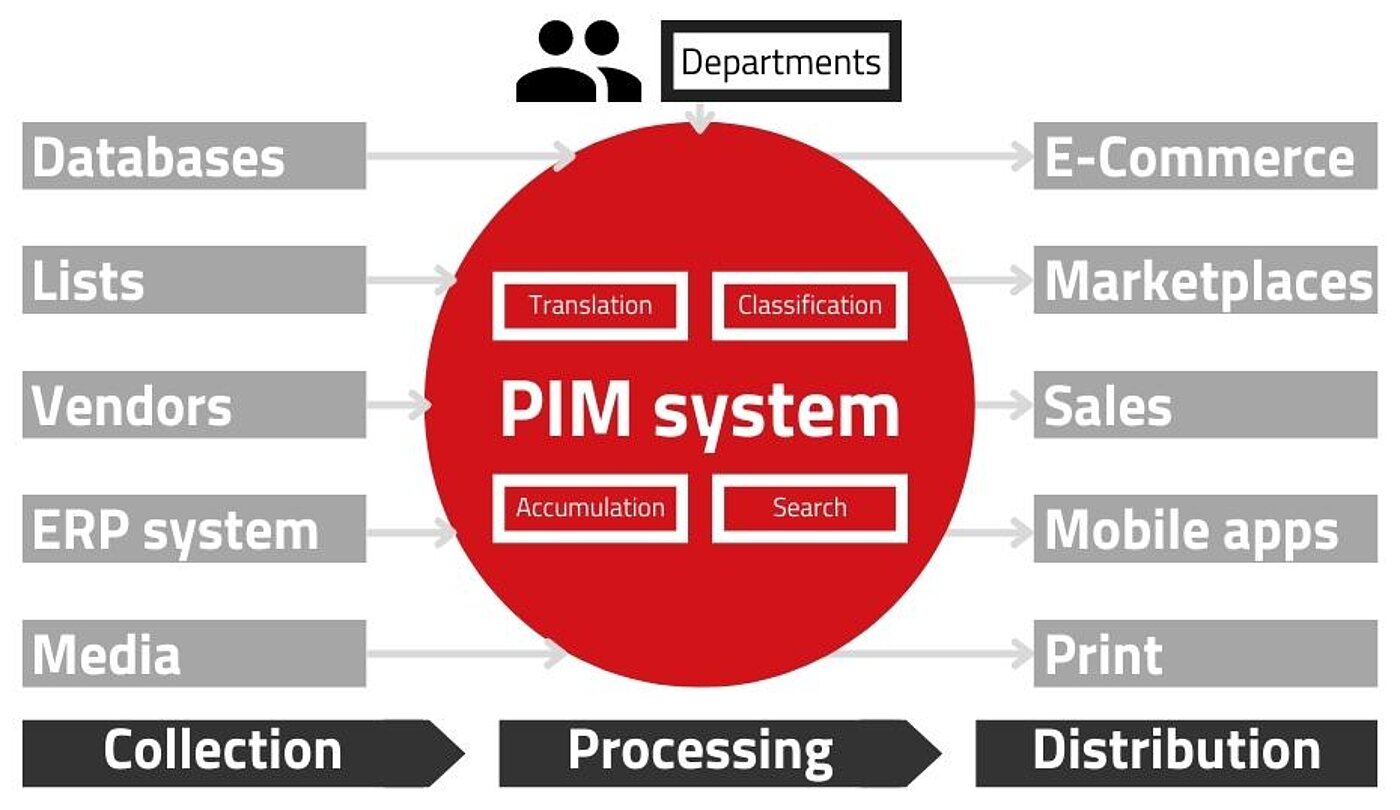
If operators of online shops still maintain their product data today in the form of decentralised and asynchronous lists, they will be left behind by the competition, especially in the long term. What can still work for shops with a small product range quickly becomes confusing, cumbersome and error-prone for more complex business models with a large product catalogue and many stakeholders involved. This is where systems like Pimcore or Akeneo come in.
How do PIM systems work?
A PIM system (short for Product Information Management) makes it possible to collect all product data centrally in one system, enrich it and distribute it from there to different channels. In this way, all stakeholders involved can access the system, store and classify data in it or supplement existing data records with information from their area of responsibility.
A PIM system replaces scattered data silos and increases the quality of product data as a central collection point. The purpose of a PIM system is therefore to ensure the consistency and quality of product data. It also helps to reduce the susceptibility to errors in data maintenance and to define clear areas of responsibility for the actors involved.

Example of how a PIM system works | Illustration: maxcluster
Technically, a PIM system communicates with other applications and systems via various interfaces. Product data from databases, ERP systems, lists and more can be transferred to the system for further processing. In addition, a PIM system offers interfaces to various distribution channels so that data can be passed on to a shop system, digital marketplaces or mobile apps, for example.
Information on further advantages of a PIM system can be found in the linked blog post.
What is Pimcore?
Pimcore is a software platform that has been available under the GPL open source licence since 2013. The company behind the software is the eponymous Pimcore GmbH, based in Salzburg, Austria. Its more than 100,000 software customers include well-known companies such as Audi, Pepsi and Dr Oetker. Alongside Akeneo, Pimcore is one of the most popular PIM solutions based on open source.
How is Pimcore structured?
In contrast to Akeneo PIM, which was designed exclusively as a solution for managing product data, Pimcore has a modular structure. Pimcore was also originally designed as a pure PIM system. In the meantime, the software has developed into a digital experience platform that contains various modules to expand its functionality. In addition to a PIM module, the solution has further components for the areas of DAM (Digital Asset Management), MDM (Master Data Management) and CDP (Customer Data Platform). Furthermore, Pimcore can be used as a headless CMS system or as an e-commerce framework.
Through its API-first approach, the platform can be connected to numerous other applications. Furthermore, additional extensions are available in the paid Pimcore editions.
The diverse application areas make the solution very flexible, but also pose a challenge due to its complexity. In the following, we take a closer look at the individual application areas.
Pimcore at a glance
Pimcore sees itself as a central digital experience platform (DXP for short) for managing all digital data and optimising the customer experience. As such, Pimcore covers a wide range of application areas with its various modules.
Product Information Management
The PIM component of Pimcore is used for the central collection and management of product data. Not least because of the API-first approach, Pimcore can be easily connected to applications such as ERP, CRM or shop systems.
The omnichannel architecture enables a smooth data transfer between Pimcore and the integrated third-party systems. In addition, multilingual data management is also easy to implement.
In this video, the provider gives a brief insight into the look & feel of the PIM dashboard:
https://www.youtube.com/watch?v=EbUnxEx3zRY
Digital Asset Management
In addition to product data management, Pimcore also contains a module for organising digital assets. Databases can be enriched with metadata and tags in order to structure them in a targeted manner. The module also contains a conversion function for various file formats (e.g. common image and video formats).
Customer Data Platform
Pimcore can also map the functionalities of a CRM system. With the Customer Data Platform, master data of customers is centrally recorded, managed and enriched. It is also possible to create 360-degree customer profiles. Existing data records can also be imported into the system via Rest API.
Based on the data records, target group segments can be formed, for example, to personalise the customer experience or to set up marketing automations.
Content and Commerce
With the Pimcore Digital Commerce Framework, it is also possible to use the software as an e-commerce solution. Pimcore brings a seamlessly integrated, responsive storefront that works out of the box. The full-text search and database management can be mapped via Elasticsearch and MySQL, for example. In addition, the system natively synchronises databases with the PIM component.
Advantages of Pimcore
When used correctly, Pimcore brings many added values. We have listed the three biggest advantages of the solution below:
- Multi-functionality: Due to the application areas already mentioned, Pimcore is an all-in-one solution that can fully map even complex system landscapes with many touchpoints. The functionality goes far beyond the management of product data.
- Flexibility: Although Pimcore can theoretically cover almost all requirements of shop operators, the system offers a high degree of flexibility based on the API-first approach and the modular structure. This means that the system can either be used in its entirety or integrated into existing IT infrastructures on a component basis. Open Code: Regardless of whether Community or Enterprise Edition - since both editions are open code, developers have full access at all times to adapt the application to individual requirements.
Pimcore Editions
Pimcore is available in four different editions. The free Community Edition contains all core functions of the solution. In addition, Pimcore can be purchased in the commercial Enterprise and Enterprise Unlimited editions.
Those who opt for one of the paid editions benefit not only from the core functions already mentioned but also, among other things, from exclusive extensions and long-term support as well as the service level agreements and extended support of the provider. The prices of the commercial editions are available from the provider on request. All three editions mentioned can be hosted on-premise.
Furthermore, the provider offers Pimcore as a SaaS model in the Cloud Edition. Here, a further distinction is made between the Cloud Editions Starter, Professional and Ultimate.
Hosting of Pimcore
Pimcore can be hosted on-premise in the Community, Enterprise and Enterprise Unlimited editions. If you are thinking about using the solution in one of the editions mentioned, consider the hardware resources required and the technical requirements that Pimcore brings with it in the desired version.
Technical requirements
The tech stack of Pimcore is based on PHP and the PHP framework Symfony. As a browser-based web application, Pimcore also requires a compatible web server such as Apache or NGINX as well as an SQL database such as MySQL or MariaDB.
The following table shows the technical requirements of the Pimcore versions supported by maxcluster.
| Software | Pimcore 6.9 | Pimcore 10.5 | Pimcore 11.0 (dev) |
|---|---|---|---|
| Ubuntu | ≥ 18.04 | ≥ 18.04 | ≥ 22.04 |
| Apache | ≥ 2.2 | ≥ 2.4 | ≥ 2.4 |
| PHP | >7.2 (bis einschl. 8.0) | ≥8.0 | ≥8.1 |
| MySQL * | ≥5.6.4 | ≥8.0. | ≥8.0. |
| MariaDB * | ≥10.0.0.5 | ≥10.3 | ≥10.3 |
| Redis (optional) | ≥ 3 | ≥ 3 | ≥ 3 |
'*' can optionally be replaced by another database management system.
Pimcore Hosting at maxcluster
At maxcluster, Pimcore can be hosted in the Community Edition and in the Enterprise Edition. We offer hosting tailored to versions 6.9 as well as 10.5.
If you already know the resources your Pimcore installation needs, feel free to use our price configurator. If you do not yet know the resources your installation requires, use our hardware finder to get a configuration recommendation.
Please note that Pimcore does not include garbage collection. Consequently, the resource requirements of the file storage will grow over time if the created assets are not manually cleaned up on a regular basis. The size of the assets or data objects also has an impact on the file storage requirements. Consequently, the size of the NVMe SSD required may vary.
If you have any questions about Pimcore hosting, please feel free to contact our technical support team by email or by phone at +49 5251 4141 350.
Conclusion
Pimcore is a flexible data and experience platform which, in addition to a powerful PIM system, also includes modules for many other areas of application. Due to its variability, the solution is well suited to cover very complex requirements. In particular, shop operators and e-commerce managers who operate extensive digital environments and want to create a native customer experience on all channels benefit.
However, since Pimcore combines many application areas in one solution, the software is also very complex. Consequently, if you choose Pimcore, you will have to calculate with greater efforts in terms of technical implementation and customisation. Since the dashboard and the functions are quite developer-centric and the solution does not work out of the box, you can also expect an increased need for training time for your staff.
However, if your requirements match the strengths of the system, the effort can be very rewarding.




